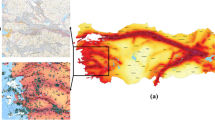Abstract
This paper evaluates the seismic vulnerability of different classes of typical bridges in California when subjected to seismic shaking or liquefaction-induced lateral spreading. The detailed structural configurations in terms of superstructure type, connection, continuity at support and foundation type, etc. render different damage resistant capability. Six classes of bridges are established based on their anticipated failure mechanisms under earthquake shaking. The numerical models that are capable of simulating the complex soil-structure interaction effects, nonlinear behavior of columns and connections are developed for each bridge class. The dynamic responses are obtained using nonlinear time history analyses for a suite of 250 earthquake motions with increasing intensity. An equivalent static analysis procedure is also implemented to evaluate the vulnerability of the bridges when subjected to liquefaction-induced lateral spreading. Fragility functions for each bridge class are derived and compared for both seismic shaking (based on nonlinear dynamic analyses) and lateral spreading (based on equivalent static analyses) for different performance states. The study finds that the fragility functions due to either ground shaking or lateral spreading show significant correlation with the structural characterizations, but differences emerge for ground shaking and lateral spreading conditions. Structural properties that will mostly affect the bridges’ damage resistant capacity are also identified.
Similar content being viewed by others
References
Baker JW and Cornell CA (2006), “Vector-valued Ground Motion Intensity Measures for Probabilistic Seismic Demand Analysis,” PEER Report 2006/08, Pacific Earthquake Engineering Research Center, University of California, Berkeley, CA.
Basöz NI and Kiremidjian AS (1998), “Evaluation of Bridge Damage Data from the Loma Prieta and Northridge, CA Earthquakes,” MCEER Report 98/04, Multidisciplinary Center for Earthquake Engineering Research, University of California, Berkeley, CA.
Basöz NI, Kiremidjian AS, King SA and Law KH (1999), “Statistical Analysis of Bridge Damage Data from the 1994 Northridge, CA, Earthquake,” Earthquake Spectra, 15(1):25–53.
Berrill JB, Christensen SA, Keenan RP, Okada W and Pettinga JR (2001), “Case Study of Lateral Spreading Forces on a Piled Foundation,” Geotechnique, 51(6): 501–517.
Boulanger RW, Chang D, Gulerce U, Brandenberg SJ and Kutter BL (2005), “Evaluating Pile Pinning Effects on Abutments over Liquefied Ground,” Simulation and Performance of Pile Foundations in Liquefied and Laterally Spreading Ground, Geotechnical Special Publication, ASCE, pp.306–318.
Brandenberg SJ, Boulanger RW, Kutter BL and Chang D (2007a), “Liquefaction-induced Softening of Load Transfer between Pile Groups and Laterally Spreading Crusts,” Journal of Geotechnical and Geoenvironmental Engineering, 133(1): 91–103.
Brandenberg SJ, Boulanger RW, Kutter BL and Chang D (2007b), “Static Pushover Analyses of Pile Groups in Liquefied and Laterally Spreading Ground in Centrifuge Tests,” Journal of Geotechnical and Geoenvironmental Engineering, 133(9): 1055–1066.
Brandenberg SJ, Kashighandi P, Zhang J, Huo Y and Zhao M (2008), “Sensitivity Study of an Older-vintage Bridge Subjected to Lateral Spreading,” Proceeding of 4th Geotechnical Earthquake Engineering and Soil Dynamics Conference, Sacramento, USA.
Chen WF and Duan L (2003), Bridge Engineering: Seismic Design, NY: CRC Press.
Choi E, DesRoches R and Nielson B (2004), “Seismic Fragility of Typical Bridges in Moderate Seismic Zones,” Engineering Structures, 26: 187–199.
Christian JT (2004), “Geotechnical Engineering Reliability: How Well Do We Know What We Are Doing?” Journal of Geotechnical and Geoenvironmental Engineering, 130(10): 985–1003.
Federal Emergency Management Agency (2007), Multi-Hazard Loss Estimation Methodology, Earthquake Model, HAZUS-MH MR3 Technical Manual, Washington, D.C.
Karim KR and Yamazaki F (2001), “Effect of Earthquake Ground Motions on Fragility Curves of Highway Bridge Piers Based on Numerical Simulation,” Earthquake Engineering and Structural Dynamics, 30: 1839–1856.
Kawashima K and Unjoh S (1997), “The Damage of Highway Bridges in the 1995 Hyogo-Ken Nanbu Earthquake and Its Impact on Japanese Seismic Design,” Journal of Earthquake Engineering, 1(3):505–541.
Kumar PTV and Paul DK (2007), “Force-deformation Behavior of Isolation Bearings,” Journal of Bridge Engineering, 12(4): 527–529.
Luco N and Bazzurro P (2007), “Does Amplitude Scaling of Ground Motion Records Result in Biased Nonlinear Structural Drift Response?” Earthquake Engineering and Structural Dynamics, 36: 1813–1835.
Mackie K and Stojadinović B (2003), “Seismic Demands for Performance-based Design of Bridges,” PEER Report No.2003/16, Pacific Earthquake Engineering Research Center, University of California, Berkeley, CA.
Mackie K and Stojadinović B (2007), “Performance-Based Seismic Bridge Design for Damage and Loss Limit States,” Earthquake Engineering and Structural Dynamics, 36(13): 1953–1971.
Martin GR, March ML, Anderson DG, Mayes RL and Power MS (2002), “Recommended Design Approach for Liquefaction Induced Lateral spreads,” Proc. of 3rd National Seismic Conf. and Workshop on Bridges and Highways, MCEER-02-SP04, Buffalo, NY.
Mazzoni S, McKenna F, Scott MH and Fenves GL et al. (2006), OpenSees Command Language Manual, University of California, Berkeley, CA.
Nielson BG and DesRoches R (2007), “Seismic Fragility Methodology for Highway Bridges Using a Component Level Approach,” Earthquake Engineering and Structural Dynamics 36: 823–839.
Padgett JE, Nielson BG and DesRoches R (2008), “Selection of Optimal Intensity Measures in Probabilistic Seismic Demand Models of Highway Bridge Portfolios,” Earthquake Engineering and Structural Dynamics, 37(5): 711–725.
Priestley MJN, Seible F and Calvi GM (1996), Seismic Design and Retrofit of Bridges, John Wiley & Sons, NY.
Shinozuka M, Feng MQ, Lee J and Naganuma T (2000), “Statistical Analysis of Fragility Curves,” Journal of Engineering Mechanics ASCE, 126(12): 1224–1231.
United States Geological Survey (USGS) (2007), CPT data Alameda County Online database: http://earthquakeusgsgov/regional/nca/cpt/data/?map=alamed.
Wilson JC (2003), “Repair of New Long-span Bridges Damaged by the 1995 Kobe Earthquake,” Journal of Performance of Constructed Facilities, 17(4): 196–205.
Yamazaki F, Motomura H and Hamada T (2000), “Damage Assessment of Expressway Networks in Japan Based on Seismic Monitoring,” Proceedings of 12th World Conference on Earthquake Engineering, Paper No. 1551, New Zealand.
Yasuda S and Berrill JB (2000), “Observations of the Earthquake Response of Foundations in Soil Profiles Containing Saturated Sands,” Proceeding of GeoEng 2000 Conference, Melbourne, Australia.
Zhang J and Huo Y (2008), “Optimum Isolation Design for Highway Bridges Using Fragility Function Method,” Proceedings of 14th World Conference on Earthquake Engineering, Beijing, China.
Zhang J, Huo Y, Kashighandi P and Brandenberg SJ (2008), “Effects of Structural Characterizations on Fragility Functions of Bridges Subjected to Seismic Shaking and Lateral Spreading,” Proceedings of the Sixth National Seismic Conference on Bridges and Highways, Charleston, S.C.
Zhang J and Makris N (2002a), “Kinematic Response Functions and Dynamic Stiffnesses of Bridge Embankments,” Earthquake Engineering and Structural Dynamics, 31: 1933–1966.
Zhang J and Makris N (2002b), “Seismic Response Analysis of Highway Overcrossings including Soil-Structure Interaction,” Earthquake Engineering and Structural Dynamics, 31: 1967–1991.
Author information
Authors and Affiliations
Corresponding author
Additional information
Supported by: Pacific Earthquake Engineering Research Center Lifelines Program Under Project Task No. 9C
Rights and permissions
About this article
Cite this article
Zhang, J., Huo, Y., Brandenberg, S.J. et al. Effects of structural characterizations on fragility functions of bridges subject to seismic shaking and lateral spreading. Earthq. Eng. Eng. Vib. 7, 369–382 (2008). https://doi.org/10.1007/s11803-008-1009-2
Received:
Accepted:
Published:
Issue Date:
DOI: https://doi.org/10.1007/s11803-008-1009-2




